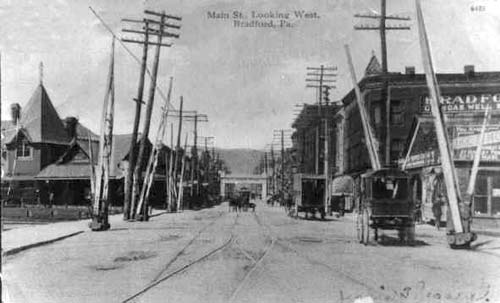
Bradford in 1900
One hundred years ago. What was Bradford really like then? We can certainly say with confidence that no one remembers that time in the city's history. But, oh, what a time to remember! So take a moment, and step back in time with the Bradford Landmark Society as we travel to Bradford in 1900. The town itself would seem very different to us. Although many streets are paved in brick, Main Street is still cobblestone. Trolleys pass up and down the streets all day, and the whistles of trains as they approach the two railroad stations at the foot of Main Street - nearly 60 of them each day - can be heard all over town. Some of the wealthy families own automobiles; Solomon Dresser drove the first one in the city in 1898. Horses and wagons still abound, but the sky above is clear and quiet - airplanes won't appear in Bradford for another 19 years. The city is crowded, with a population of over 18,000, and Bradford is bursting with new businesses and industries. The 1900 City Directory lists 30 barbers, 10 bakers, 2 Turkish baths, 11 bicycle shops, 5 billiard parlors, 29 boarding houses, 1 brewery, 6 cigar makers, 2 butter dish manufacturers, 11 shoe stores, 3 banks, 3 architects, 3 chiropodists, 8 carriage and wagon makers, 9 dentists, 65 dressmakers, 13 druggists, 10 fruit dealers, 7 florists, 55 grocers, 10 horseshoers, 23 hotels, 11 livery stables, 24 lawyers, 11 laundries (7 of them Chinese), 19 meat markets, 154 oil producers, 3 refineries, 4 opticians, 3 piano tuners, 5 photographers, 28 doctors, 14 restaurants, 1 silk mill, 2 table relish manufacturers, and 1 clairvoyant named Lulu. Several large buildings that we know today have not even been built yet. The Schonblom building on the comer of Kennedy and Main, and the James R. Evans building across the street are still several years away. The Option House is made of wood, and will soon be replaced by a brand new, brick building with a beautiful facade. The Emery Hotel is still years away from existing, as is the present day Seneca building, the Hooker Fulton, the hospital, and the Armory. City Hall, which has recently been erected and is the pride of the city, will be nearly destroyed by fire with the next year. The Herbig Bakery, on Corydon Street, recently celebrates its 25th year of baking bread. All this in 1900. The new high school at the top of Mechanic Street is being constructed at a cost of $35,000, but will be outgrown by the early 1920s, and will be replaced with the present day one on Interstate Parkway. Total enrollment in the city is 2,728 students. Hobson Place is being developed. The Iron and Oil baseball league comprised of Bradford, Warren, Celeron, Oil City and Meadville is a popular pastime. The new city reservoir - Marilla - is finally completed after two years, as is the stone wall on South Avenue. Carnegie Public Library is under construction. The police force has seven men, the volunteer fire department, over 400. There are ten miles of paved streets, and twenty-five miles of sidewalks. There are three daily newspapers, two Sunday, and two weekly papers. Three refineries, the Emery, the Orient, and the Hoffinan keep many employed. And for the adventuresome, the Gold Rush in Alaska is on. An article written by John J. McLaurin, author of "Sketches in Oil", a book detailing the history of the oil boom in western Pennsylvania wrote: "The contrast between the dingy, Rip Van Winkle cross roads village of 1875 and the thriving, bustling, get-up- and-get metropolis of 1900 is simple marvelous". As a man who had seen the early days of Bradford, !McLaurin knew firsthand of the tremendous growth of the city in only 25 years. A reporter for a Harrisburg newspaper, he had traveled throughout this region for over half his lifetime. Yes, the Bradford of 1900 was loud, prosperous, growing, and alive. The discovery of oil had changed the image of Littleton, a small lumber town, to the energetic city that was Bradford. "Petroleum touched the Tuna Valley with its magic wand" marveled !McLaurin, and "what a wondrous transformation oil has wrought". |
